Cognitive Biases in Management: A Detailed Decision-Making Analysis
VerifiedAdded on 2020/02/19
|27
|6771
|44
Report
AI Summary
This report analyzes cognitive biases, as identified by David Arnott, and their impact on managerial decision-making within organizations. The study focuses on ten specific cognitive biases, including hindsight bias, overconfidence bias, correlation bias, desire bias, conservatism bias, complexity bias, attenuation bias, imaginability bias, redundancy bias, and similarity bias. Each bias is explained in detail, with real-world examples from various organizational contexts, such as Cotton On, Motorola, and Volkswagen, to illustrate their effects on managerial decisions. The report explores how these biases can lead to suboptimal outcomes, hindering effective leadership and strategic planning. It emphasizes the importance of recognizing and mitigating these biases to improve the quality of managerial decisions and enhance organizational success. The study provides a comprehensive overview of the cognitive biases, their manifestation, and their implications within the context of business management.
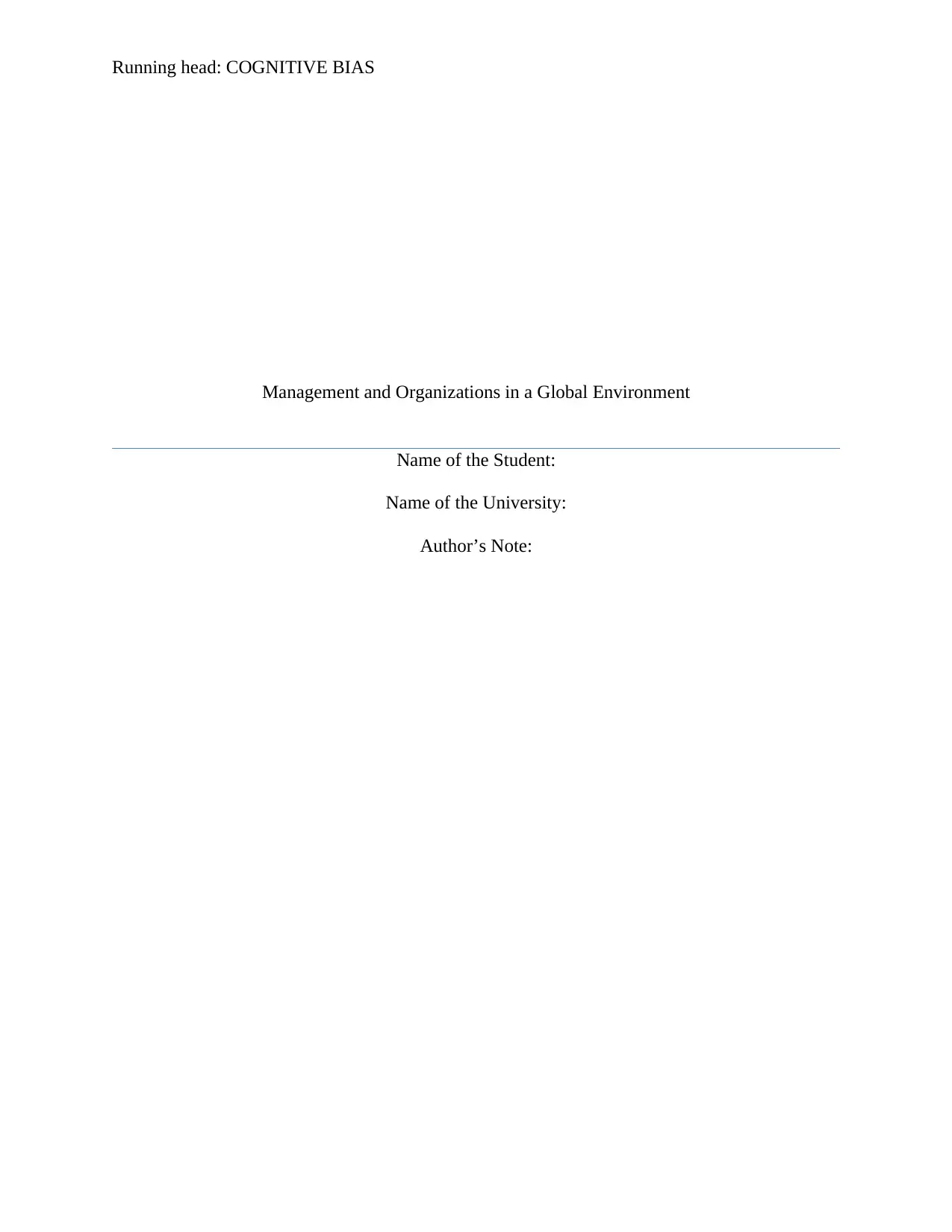
Running head: COGNITIVE BIAS
Management and Organizations in a Global Environment
Name of the Student:
Name of the University:
Author’s Note:
Management and Organizations in a Global Environment
Name of the Student:
Name of the University:
Author’s Note:
Paraphrase This Document
Need a fresh take? Get an instant paraphrase of this document with our AI Paraphraser
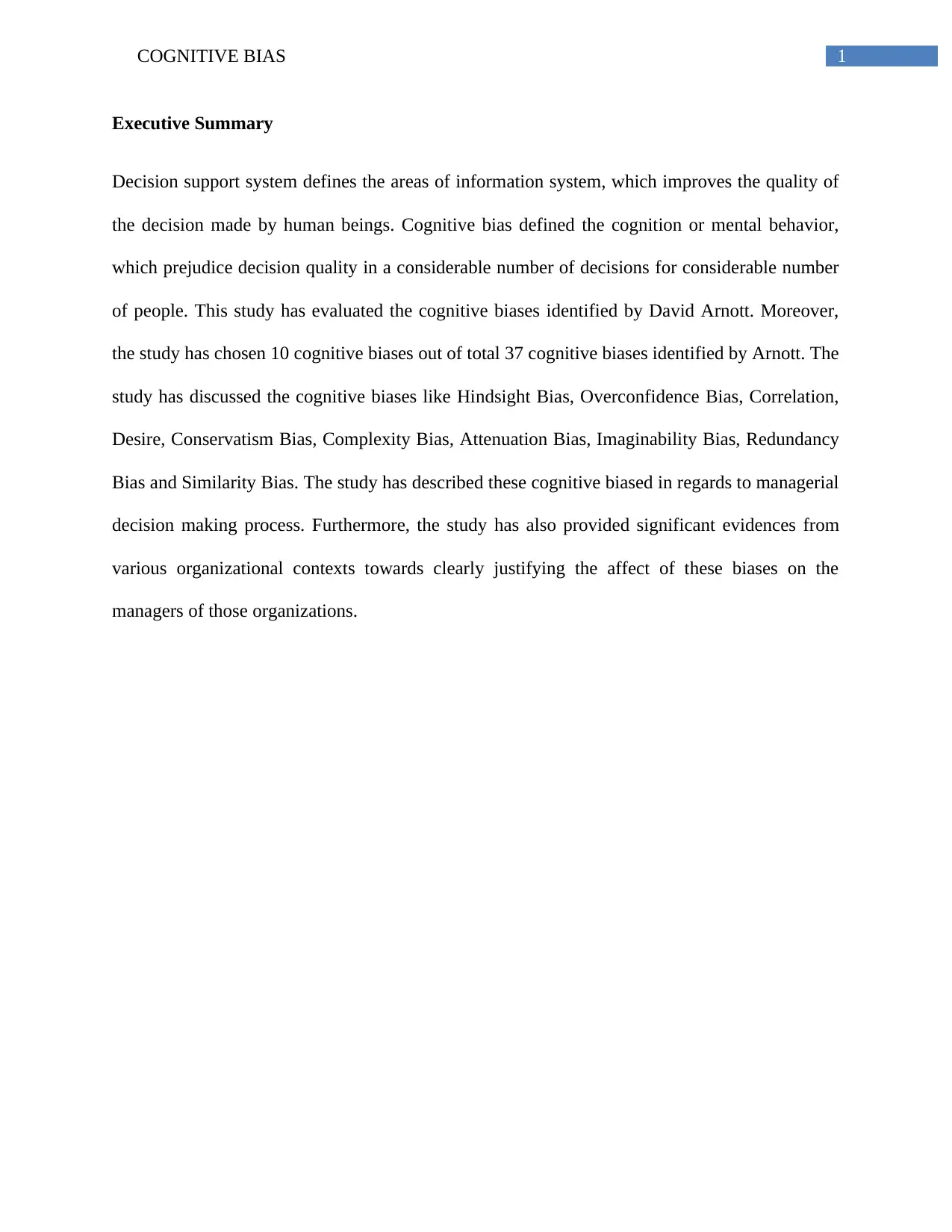
1COGNITIVE BIAS
Executive Summary
Decision support system defines the areas of information system, which improves the quality of
the decision made by human beings. Cognitive bias defined the cognition or mental behavior,
which prejudice decision quality in a considerable number of decisions for considerable number
of people. This study has evaluated the cognitive biases identified by David Arnott. Moreover,
the study has chosen 10 cognitive biases out of total 37 cognitive biases identified by Arnott. The
study has discussed the cognitive biases like Hindsight Bias, Overconfidence Bias, Correlation,
Desire, Conservatism Bias, Complexity Bias, Attenuation Bias, Imaginability Bias, Redundancy
Bias and Similarity Bias. The study has described these cognitive biased in regards to managerial
decision making process. Furthermore, the study has also provided significant evidences from
various organizational contexts towards clearly justifying the affect of these biases on the
managers of those organizations.
Executive Summary
Decision support system defines the areas of information system, which improves the quality of
the decision made by human beings. Cognitive bias defined the cognition or mental behavior,
which prejudice decision quality in a considerable number of decisions for considerable number
of people. This study has evaluated the cognitive biases identified by David Arnott. Moreover,
the study has chosen 10 cognitive biases out of total 37 cognitive biases identified by Arnott. The
study has discussed the cognitive biases like Hindsight Bias, Overconfidence Bias, Correlation,
Desire, Conservatism Bias, Complexity Bias, Attenuation Bias, Imaginability Bias, Redundancy
Bias and Similarity Bias. The study has described these cognitive biased in regards to managerial
decision making process. Furthermore, the study has also provided significant evidences from
various organizational contexts towards clearly justifying the affect of these biases on the
managers of those organizations.
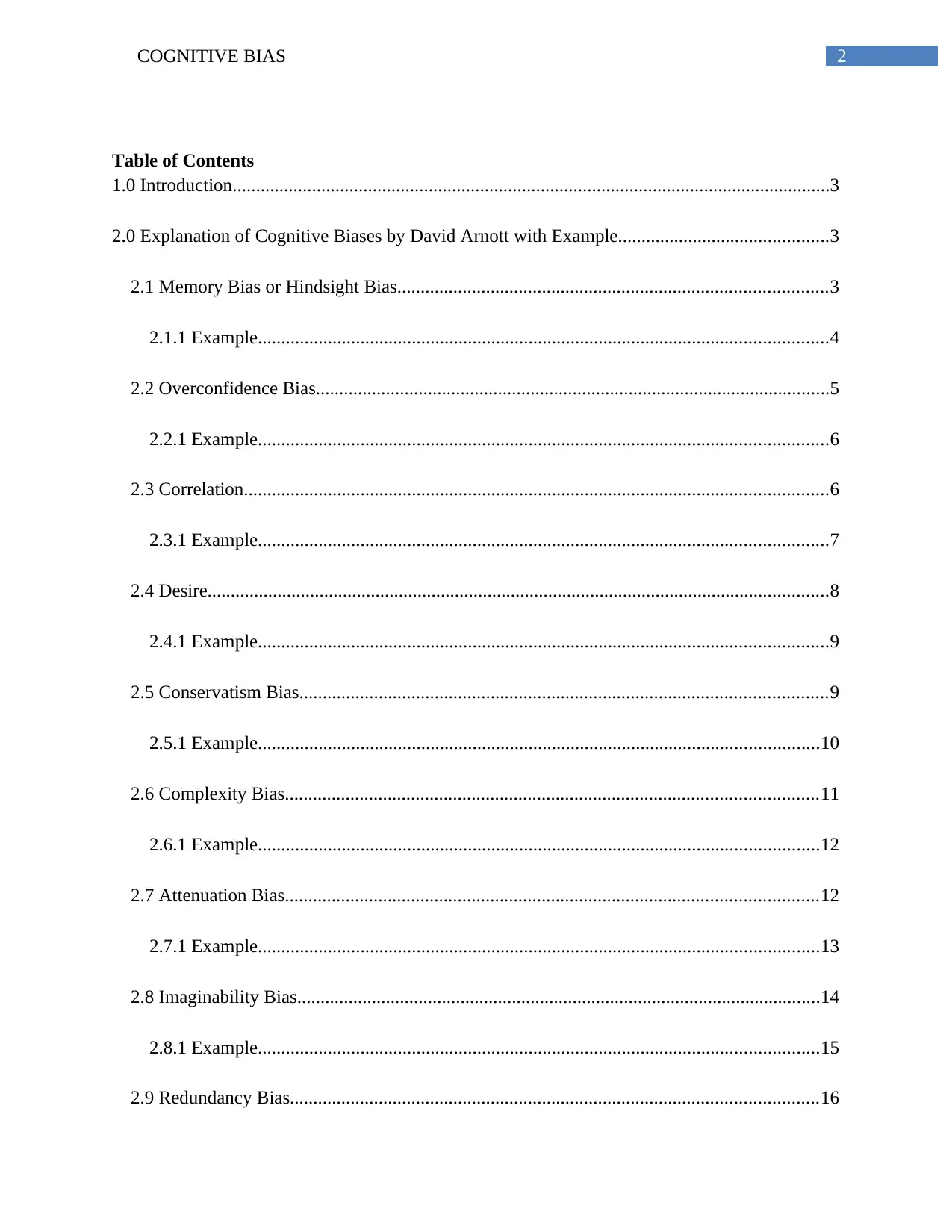
2COGNITIVE BIAS
Table of Contents
1.0 Introduction................................................................................................................................3
2.0 Explanation of Cognitive Biases by David Arnott with Example.............................................3
2.1 Memory Bias or Hindsight Bias............................................................................................3
2.1.1 Example..........................................................................................................................4
2.2 Overconfidence Bias..............................................................................................................5
2.2.1 Example..........................................................................................................................6
2.3 Correlation.............................................................................................................................6
2.3.1 Example..........................................................................................................................7
2.4 Desire.....................................................................................................................................8
2.4.1 Example..........................................................................................................................9
2.5 Conservatism Bias.................................................................................................................9
2.5.1 Example........................................................................................................................10
2.6 Complexity Bias..................................................................................................................11
2.6.1 Example........................................................................................................................12
2.7 Attenuation Bias..................................................................................................................12
2.7.1 Example........................................................................................................................13
2.8 Imaginability Bias................................................................................................................14
2.8.1 Example........................................................................................................................15
2.9 Redundancy Bias.................................................................................................................16
Table of Contents
1.0 Introduction................................................................................................................................3
2.0 Explanation of Cognitive Biases by David Arnott with Example.............................................3
2.1 Memory Bias or Hindsight Bias............................................................................................3
2.1.1 Example..........................................................................................................................4
2.2 Overconfidence Bias..............................................................................................................5
2.2.1 Example..........................................................................................................................6
2.3 Correlation.............................................................................................................................6
2.3.1 Example..........................................................................................................................7
2.4 Desire.....................................................................................................................................8
2.4.1 Example..........................................................................................................................9
2.5 Conservatism Bias.................................................................................................................9
2.5.1 Example........................................................................................................................10
2.6 Complexity Bias..................................................................................................................11
2.6.1 Example........................................................................................................................12
2.7 Attenuation Bias..................................................................................................................12
2.7.1 Example........................................................................................................................13
2.8 Imaginability Bias................................................................................................................14
2.8.1 Example........................................................................................................................15
2.9 Redundancy Bias.................................................................................................................16
⊘ This is a preview!⊘
Do you want full access?
Subscribe today to unlock all pages.

Trusted by 1+ million students worldwide
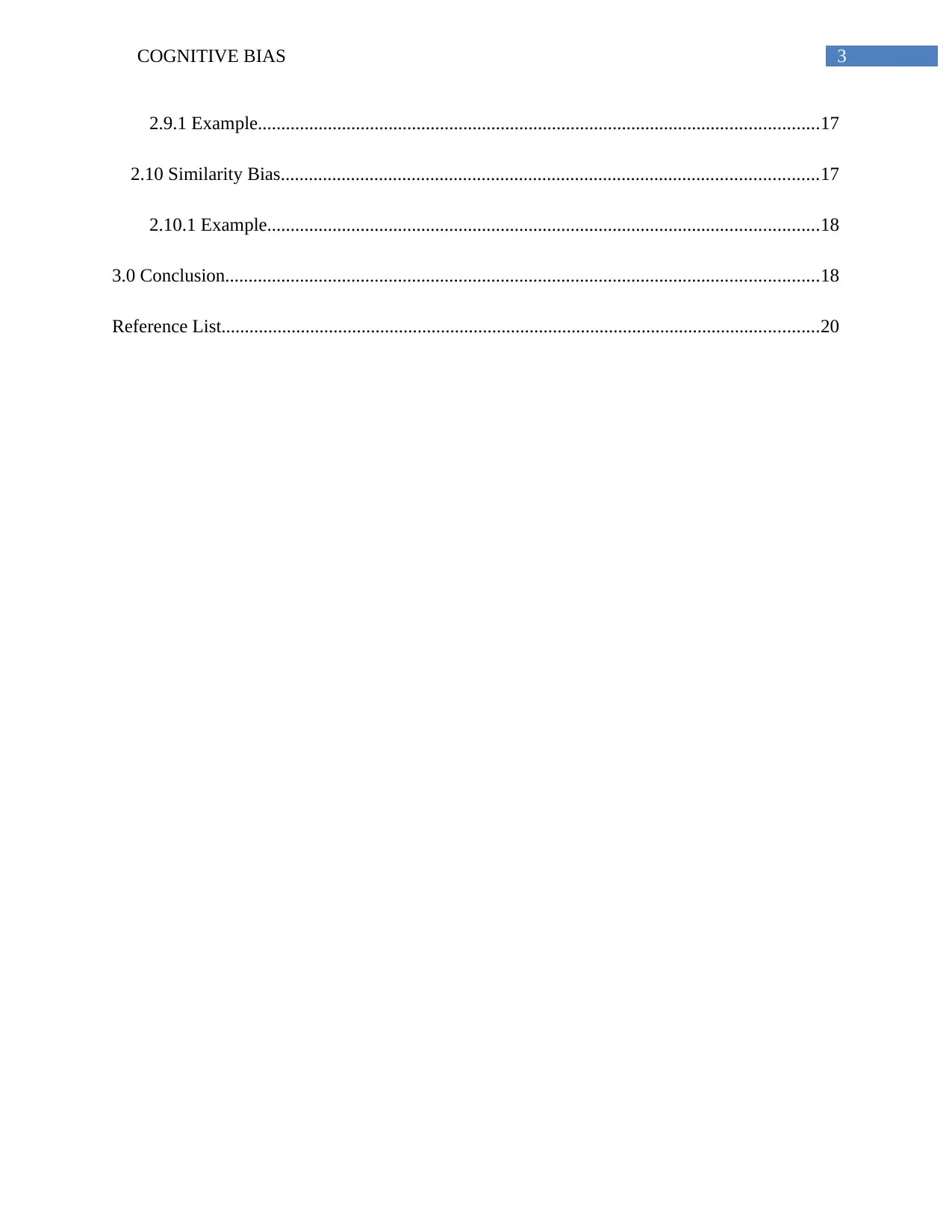
3COGNITIVE BIAS
2.9.1 Example........................................................................................................................17
2.10 Similarity Bias...................................................................................................................17
2.10.1 Example......................................................................................................................18
3.0 Conclusion...............................................................................................................................18
Reference List................................................................................................................................20
2.9.1 Example........................................................................................................................17
2.10 Similarity Bias...................................................................................................................17
2.10.1 Example......................................................................................................................18
3.0 Conclusion...............................................................................................................................18
Reference List................................................................................................................................20
Paraphrase This Document
Need a fresh take? Get an instant paraphrase of this document with our AI Paraphraser
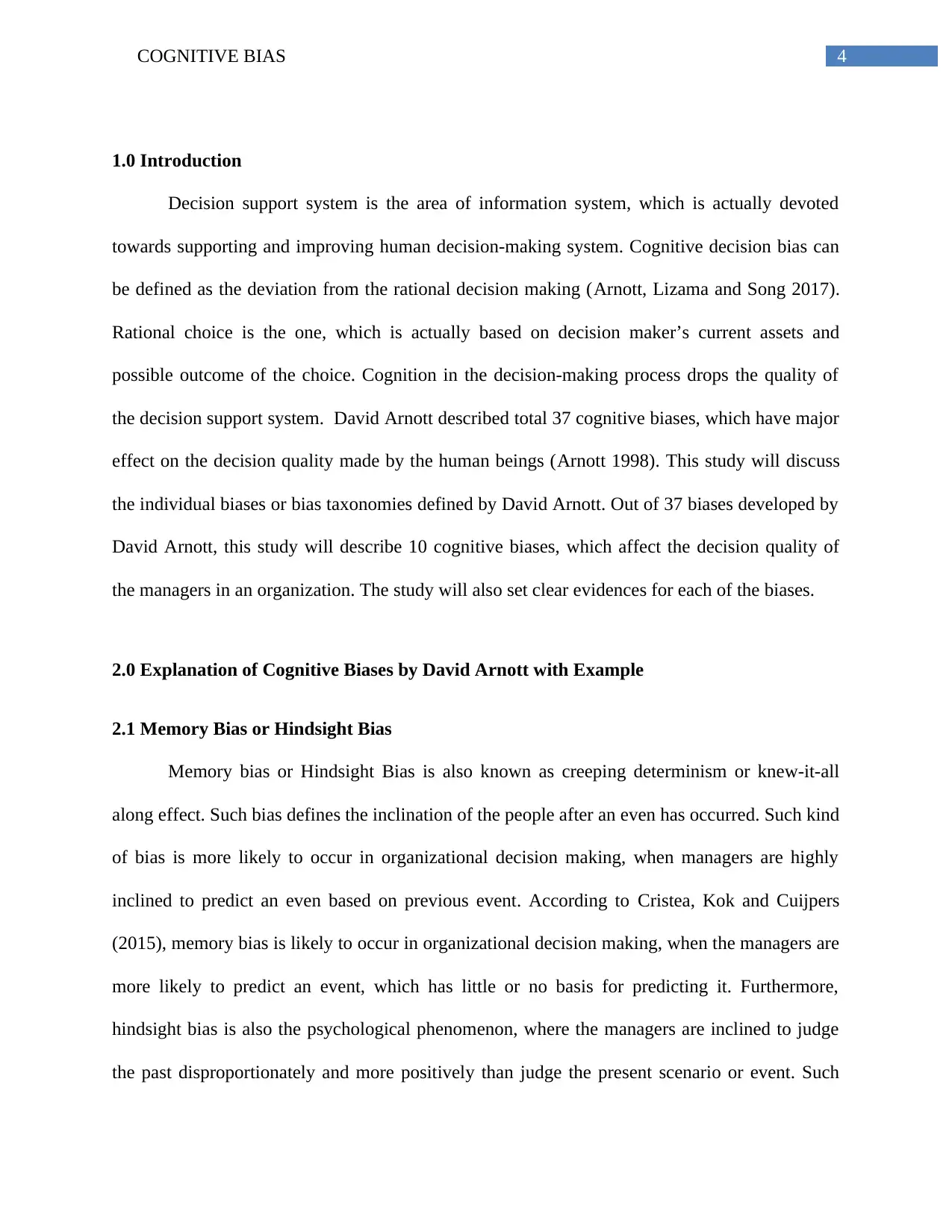
4COGNITIVE BIAS
1.0 Introduction
Decision support system is the area of information system, which is actually devoted
towards supporting and improving human decision-making system. Cognitive decision bias can
be defined as the deviation from the rational decision making (Arnott, Lizama and Song 2017).
Rational choice is the one, which is actually based on decision maker’s current assets and
possible outcome of the choice. Cognition in the decision-making process drops the quality of
the decision support system. David Arnott described total 37 cognitive biases, which have major
effect on the decision quality made by the human beings (Arnott 1998). This study will discuss
the individual biases or bias taxonomies defined by David Arnott. Out of 37 biases developed by
David Arnott, this study will describe 10 cognitive biases, which affect the decision quality of
the managers in an organization. The study will also set clear evidences for each of the biases.
2.0 Explanation of Cognitive Biases by David Arnott with Example
2.1 Memory Bias or Hindsight Bias
Memory bias or Hindsight Bias is also known as creeping determinism or knew-it-all
along effect. Such bias defines the inclination of the people after an even has occurred. Such kind
of bias is more likely to occur in organizational decision making, when managers are highly
inclined to predict an even based on previous event. According to Cristea, Kok and Cuijpers
(2015), memory bias is likely to occur in organizational decision making, when the managers are
more likely to predict an event, which has little or no basis for predicting it. Furthermore,
hindsight bias is also the psychological phenomenon, where the managers are inclined to judge
the past disproportionately and more positively than judge the present scenario or event. Such
1.0 Introduction
Decision support system is the area of information system, which is actually devoted
towards supporting and improving human decision-making system. Cognitive decision bias can
be defined as the deviation from the rational decision making (Arnott, Lizama and Song 2017).
Rational choice is the one, which is actually based on decision maker’s current assets and
possible outcome of the choice. Cognition in the decision-making process drops the quality of
the decision support system. David Arnott described total 37 cognitive biases, which have major
effect on the decision quality made by the human beings (Arnott 1998). This study will discuss
the individual biases or bias taxonomies defined by David Arnott. Out of 37 biases developed by
David Arnott, this study will describe 10 cognitive biases, which affect the decision quality of
the managers in an organization. The study will also set clear evidences for each of the biases.
2.0 Explanation of Cognitive Biases by David Arnott with Example
2.1 Memory Bias or Hindsight Bias
Memory bias or Hindsight Bias is also known as creeping determinism or knew-it-all
along effect. Such bias defines the inclination of the people after an even has occurred. Such kind
of bias is more likely to occur in organizational decision making, when managers are highly
inclined to predict an even based on previous event. According to Cristea, Kok and Cuijpers
(2015), memory bias is likely to occur in organizational decision making, when the managers are
more likely to predict an event, which has little or no basis for predicting it. Furthermore,
hindsight bias is also the psychological phenomenon, where the managers are inclined to judge
the past disproportionately and more positively than judge the present scenario or event. Such
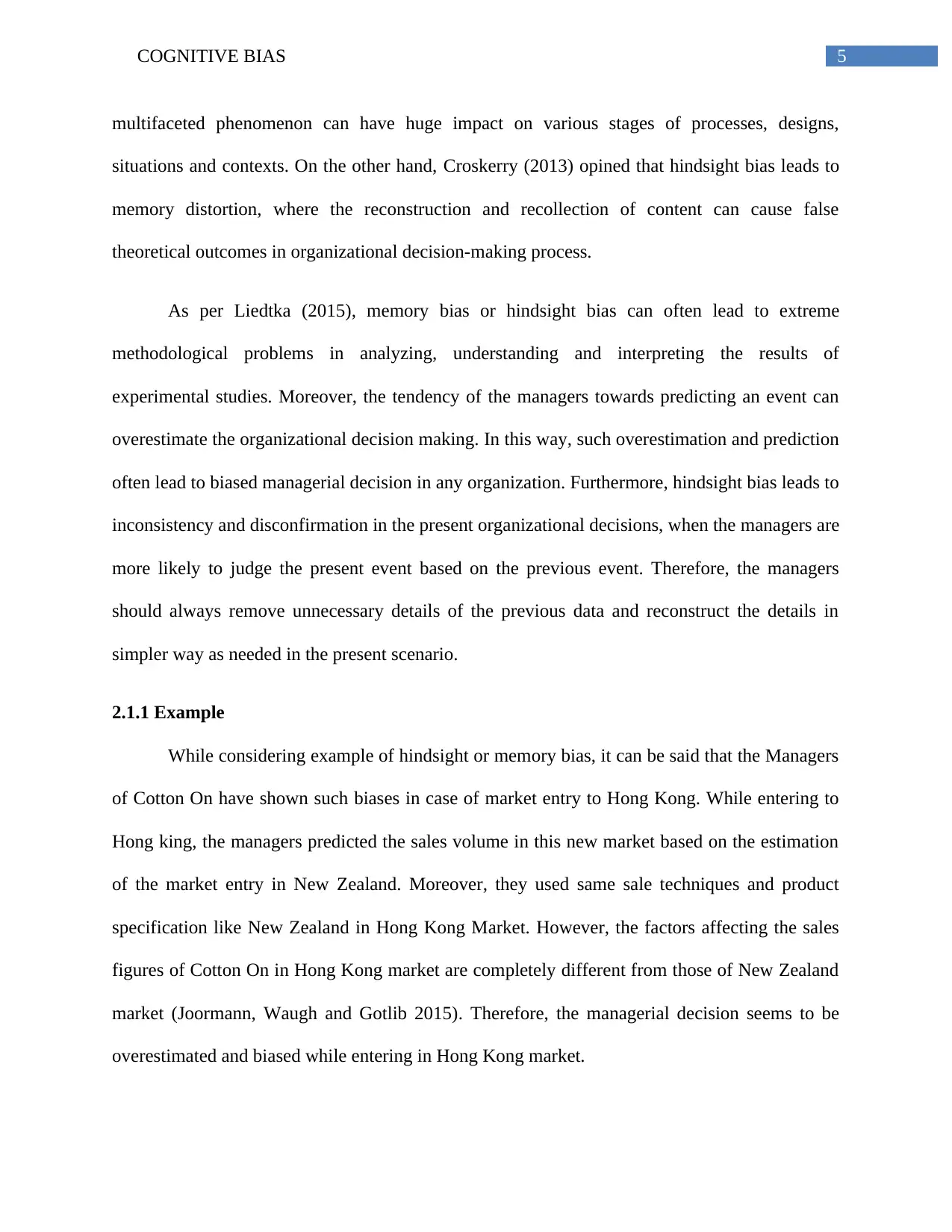
5COGNITIVE BIAS
multifaceted phenomenon can have huge impact on various stages of processes, designs,
situations and contexts. On the other hand, Croskerry (2013) opined that hindsight bias leads to
memory distortion, where the reconstruction and recollection of content can cause false
theoretical outcomes in organizational decision-making process.
As per Liedtka (2015), memory bias or hindsight bias can often lead to extreme
methodological problems in analyzing, understanding and interpreting the results of
experimental studies. Moreover, the tendency of the managers towards predicting an event can
overestimate the organizational decision making. In this way, such overestimation and prediction
often lead to biased managerial decision in any organization. Furthermore, hindsight bias leads to
inconsistency and disconfirmation in the present organizational decisions, when the managers are
more likely to judge the present event based on the previous event. Therefore, the managers
should always remove unnecessary details of the previous data and reconstruct the details in
simpler way as needed in the present scenario.
2.1.1 Example
While considering example of hindsight or memory bias, it can be said that the Managers
of Cotton On have shown such biases in case of market entry to Hong Kong. While entering to
Hong king, the managers predicted the sales volume in this new market based on the estimation
of the market entry in New Zealand. Moreover, they used same sale techniques and product
specification like New Zealand in Hong Kong Market. However, the factors affecting the sales
figures of Cotton On in Hong Kong market are completely different from those of New Zealand
market (Joormann, Waugh and Gotlib 2015). Therefore, the managerial decision seems to be
overestimated and biased while entering in Hong Kong market.
multifaceted phenomenon can have huge impact on various stages of processes, designs,
situations and contexts. On the other hand, Croskerry (2013) opined that hindsight bias leads to
memory distortion, where the reconstruction and recollection of content can cause false
theoretical outcomes in organizational decision-making process.
As per Liedtka (2015), memory bias or hindsight bias can often lead to extreme
methodological problems in analyzing, understanding and interpreting the results of
experimental studies. Moreover, the tendency of the managers towards predicting an event can
overestimate the organizational decision making. In this way, such overestimation and prediction
often lead to biased managerial decision in any organization. Furthermore, hindsight bias leads to
inconsistency and disconfirmation in the present organizational decisions, when the managers are
more likely to judge the present event based on the previous event. Therefore, the managers
should always remove unnecessary details of the previous data and reconstruct the details in
simpler way as needed in the present scenario.
2.1.1 Example
While considering example of hindsight or memory bias, it can be said that the Managers
of Cotton On have shown such biases in case of market entry to Hong Kong. While entering to
Hong king, the managers predicted the sales volume in this new market based on the estimation
of the market entry in New Zealand. Moreover, they used same sale techniques and product
specification like New Zealand in Hong Kong Market. However, the factors affecting the sales
figures of Cotton On in Hong Kong market are completely different from those of New Zealand
market (Joormann, Waugh and Gotlib 2015). Therefore, the managerial decision seems to be
overestimated and biased while entering in Hong Kong market.
⊘ This is a preview!⊘
Do you want full access?
Subscribe today to unlock all pages.

Trusted by 1+ million students worldwide

6COGNITIVE BIAS
Paraphrase This Document
Need a fresh take? Get an instant paraphrase of this document with our AI Paraphraser
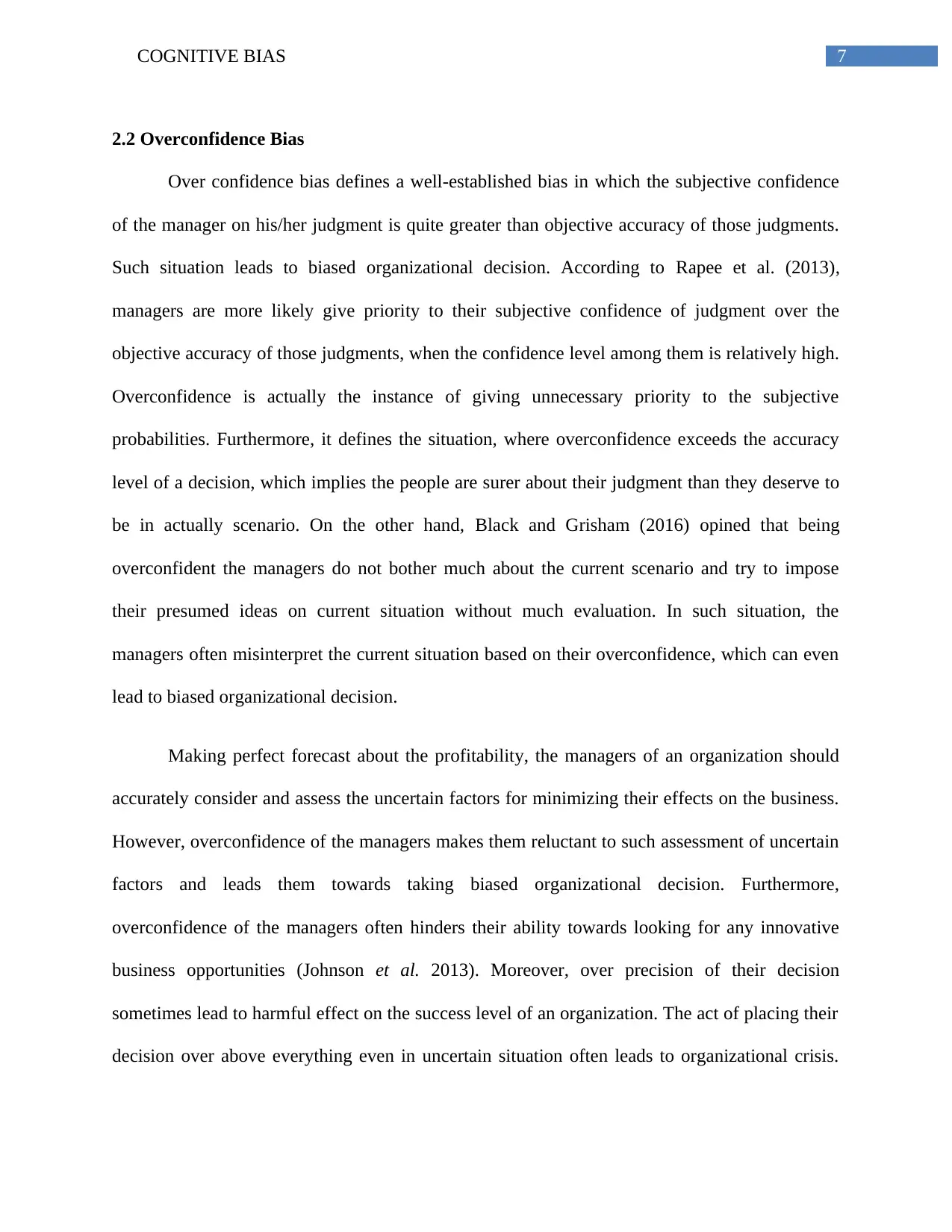
7COGNITIVE BIAS
2.2 Overconfidence Bias
Over confidence bias defines a well-established bias in which the subjective confidence
of the manager on his/her judgment is quite greater than objective accuracy of those judgments.
Such situation leads to biased organizational decision. According to Rapee et al. (2013),
managers are more likely give priority to their subjective confidence of judgment over the
objective accuracy of those judgments, when the confidence level among them is relatively high.
Overconfidence is actually the instance of giving unnecessary priority to the subjective
probabilities. Furthermore, it defines the situation, where overconfidence exceeds the accuracy
level of a decision, which implies the people are surer about their judgment than they deserve to
be in actually scenario. On the other hand, Black and Grisham (2016) opined that being
overconfident the managers do not bother much about the current scenario and try to impose
their presumed ideas on current situation without much evaluation. In such situation, the
managers often misinterpret the current situation based on their overconfidence, which can even
lead to biased organizational decision.
Making perfect forecast about the profitability, the managers of an organization should
accurately consider and assess the uncertain factors for minimizing their effects on the business.
However, overconfidence of the managers makes them reluctant to such assessment of uncertain
factors and leads them towards taking biased organizational decision. Furthermore,
overconfidence of the managers often hinders their ability towards looking for any innovative
business opportunities (Johnson et al. 2013). Moreover, over precision of their decision
sometimes lead to harmful effect on the success level of an organization. The act of placing their
decision over above everything even in uncertain situation often leads to organizational crisis.
2.2 Overconfidence Bias
Over confidence bias defines a well-established bias in which the subjective confidence
of the manager on his/her judgment is quite greater than objective accuracy of those judgments.
Such situation leads to biased organizational decision. According to Rapee et al. (2013),
managers are more likely give priority to their subjective confidence of judgment over the
objective accuracy of those judgments, when the confidence level among them is relatively high.
Overconfidence is actually the instance of giving unnecessary priority to the subjective
probabilities. Furthermore, it defines the situation, where overconfidence exceeds the accuracy
level of a decision, which implies the people are surer about their judgment than they deserve to
be in actually scenario. On the other hand, Black and Grisham (2016) opined that being
overconfident the managers do not bother much about the current scenario and try to impose
their presumed ideas on current situation without much evaluation. In such situation, the
managers often misinterpret the current situation based on their overconfidence, which can even
lead to biased organizational decision.
Making perfect forecast about the profitability, the managers of an organization should
accurately consider and assess the uncertain factors for minimizing their effects on the business.
However, overconfidence of the managers makes them reluctant to such assessment of uncertain
factors and leads them towards taking biased organizational decision. Furthermore,
overconfidence of the managers often hinders their ability towards looking for any innovative
business opportunities (Johnson et al. 2013). Moreover, over precision of their decision
sometimes lead to harmful effect on the success level of an organization. The act of placing their
decision over above everything even in uncertain situation often leads to organizational crisis.
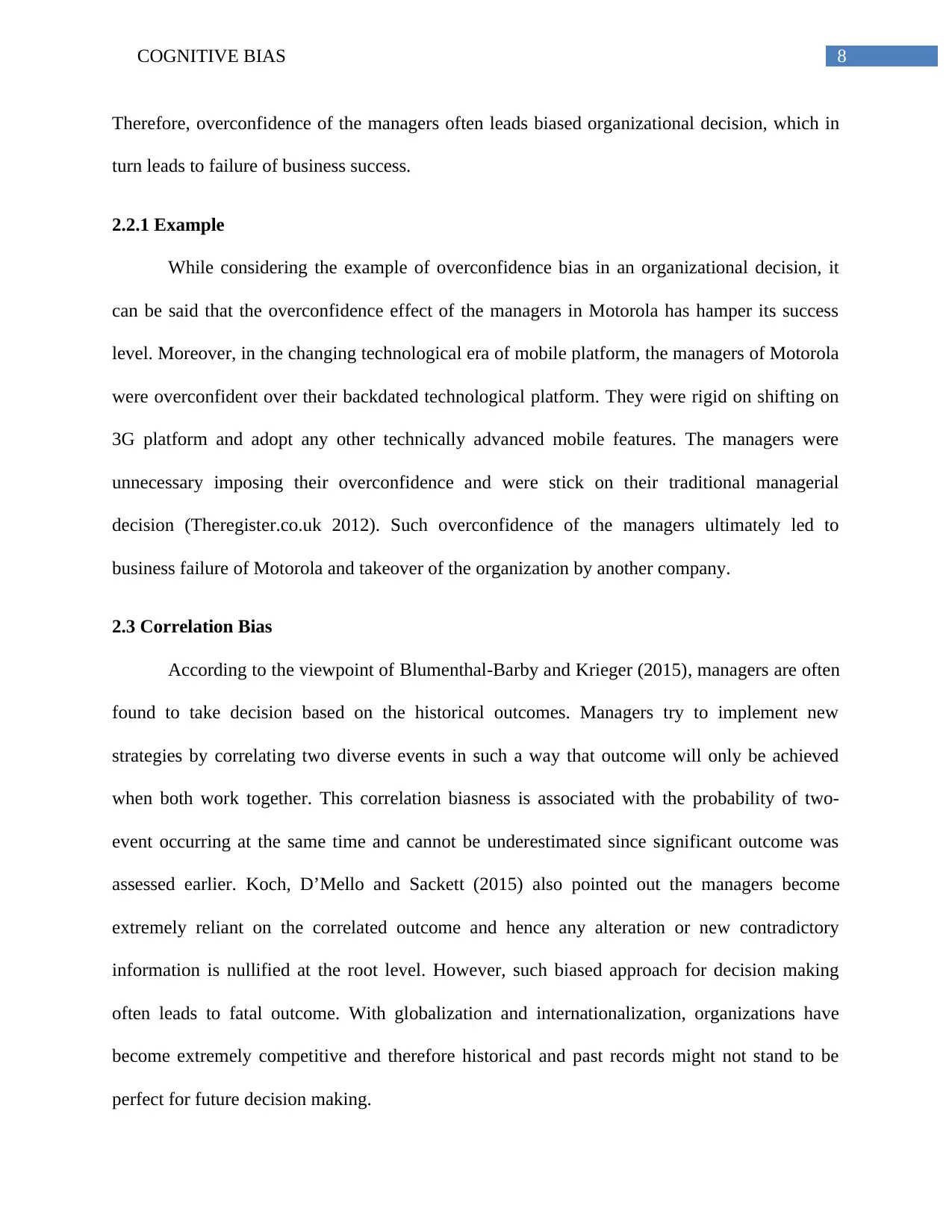
8COGNITIVE BIAS
Therefore, overconfidence of the managers often leads biased organizational decision, which in
turn leads to failure of business success.
2.2.1 Example
While considering the example of overconfidence bias in an organizational decision, it
can be said that the overconfidence effect of the managers in Motorola has hamper its success
level. Moreover, in the changing technological era of mobile platform, the managers of Motorola
were overconfident over their backdated technological platform. They were rigid on shifting on
3G platform and adopt any other technically advanced mobile features. The managers were
unnecessary imposing their overconfidence and were stick on their traditional managerial
decision (Theregister.co.uk 2012). Such overconfidence of the managers ultimately led to
business failure of Motorola and takeover of the organization by another company.
2.3 Correlation Bias
According to the viewpoint of Blumenthal-Barby and Krieger (2015), managers are often
found to take decision based on the historical outcomes. Managers try to implement new
strategies by correlating two diverse events in such a way that outcome will only be achieved
when both work together. This correlation biasness is associated with the probability of two-
event occurring at the same time and cannot be underestimated since significant outcome was
assessed earlier. Koch, D’Mello and Sackett (2015) also pointed out the managers become
extremely reliant on the correlated outcome and hence any alteration or new contradictory
information is nullified at the root level. However, such biased approach for decision making
often leads to fatal outcome. With globalization and internationalization, organizations have
become extremely competitive and therefore historical and past records might not stand to be
perfect for future decision making.
Therefore, overconfidence of the managers often leads biased organizational decision, which in
turn leads to failure of business success.
2.2.1 Example
While considering the example of overconfidence bias in an organizational decision, it
can be said that the overconfidence effect of the managers in Motorola has hamper its success
level. Moreover, in the changing technological era of mobile platform, the managers of Motorola
were overconfident over their backdated technological platform. They were rigid on shifting on
3G platform and adopt any other technically advanced mobile features. The managers were
unnecessary imposing their overconfidence and were stick on their traditional managerial
decision (Theregister.co.uk 2012). Such overconfidence of the managers ultimately led to
business failure of Motorola and takeover of the organization by another company.
2.3 Correlation Bias
According to the viewpoint of Blumenthal-Barby and Krieger (2015), managers are often
found to take decision based on the historical outcomes. Managers try to implement new
strategies by correlating two diverse events in such a way that outcome will only be achieved
when both work together. This correlation biasness is associated with the probability of two-
event occurring at the same time and cannot be underestimated since significant outcome was
assessed earlier. Koch, D’Mello and Sackett (2015) also pointed out the managers become
extremely reliant on the correlated outcome and hence any alteration or new contradictory
information is nullified at the root level. However, such biased approach for decision making
often leads to fatal outcome. With globalization and internationalization, organizations have
become extremely competitive and therefore historical and past records might not stand to be
perfect for future decision making.
⊘ This is a preview!⊘
Do you want full access?
Subscribe today to unlock all pages.

Trusted by 1+ million students worldwide
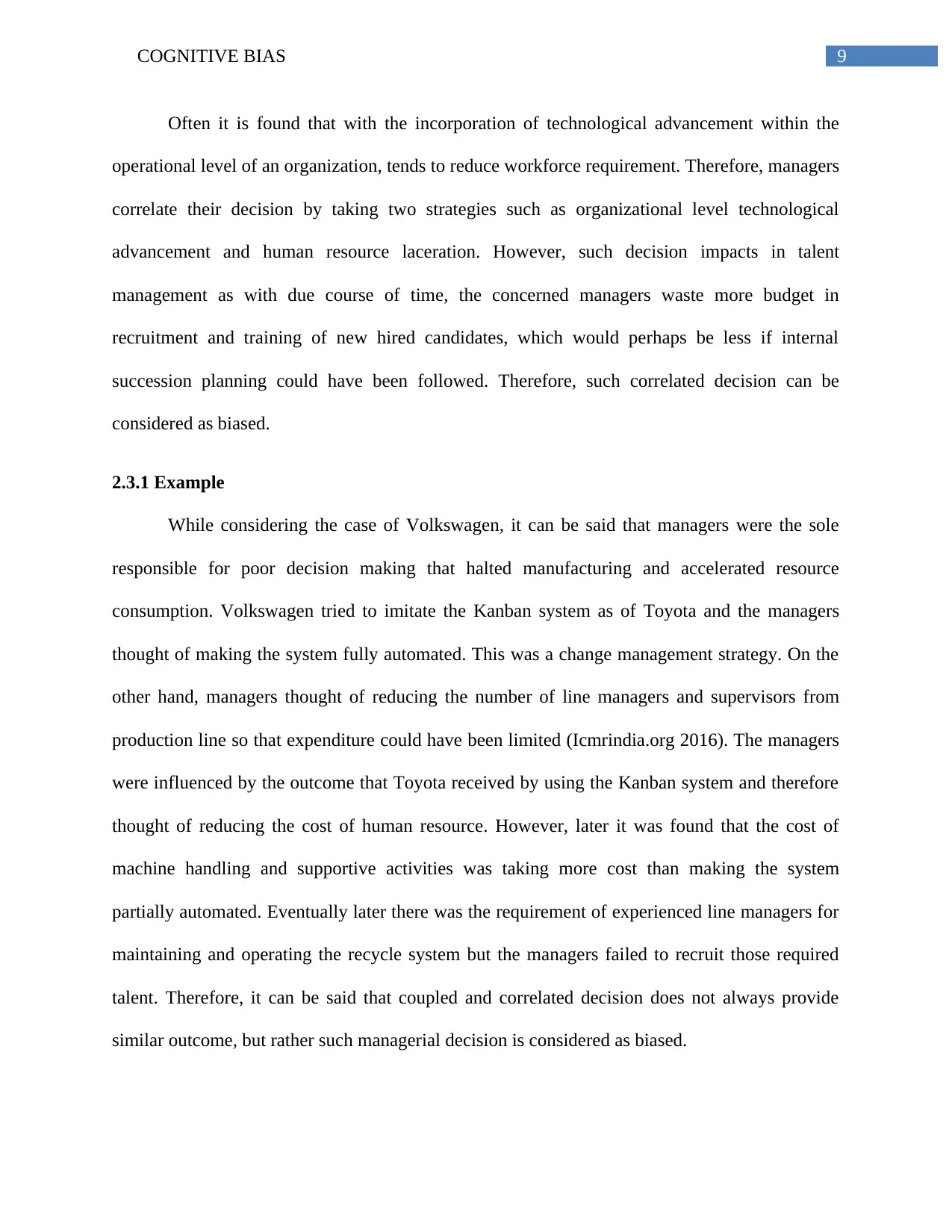
9COGNITIVE BIAS
Often it is found that with the incorporation of technological advancement within the
operational level of an organization, tends to reduce workforce requirement. Therefore, managers
correlate their decision by taking two strategies such as organizational level technological
advancement and human resource laceration. However, such decision impacts in talent
management as with due course of time, the concerned managers waste more budget in
recruitment and training of new hired candidates, which would perhaps be less if internal
succession planning could have been followed. Therefore, such correlated decision can be
considered as biased.
2.3.1 Example
While considering the case of Volkswagen, it can be said that managers were the sole
responsible for poor decision making that halted manufacturing and accelerated resource
consumption. Volkswagen tried to imitate the Kanban system as of Toyota and the managers
thought of making the system fully automated. This was a change management strategy. On the
other hand, managers thought of reducing the number of line managers and supervisors from
production line so that expenditure could have been limited (Icmrindia.org 2016). The managers
were influenced by the outcome that Toyota received by using the Kanban system and therefore
thought of reducing the cost of human resource. However, later it was found that the cost of
machine handling and supportive activities was taking more cost than making the system
partially automated. Eventually later there was the requirement of experienced line managers for
maintaining and operating the recycle system but the managers failed to recruit those required
talent. Therefore, it can be said that coupled and correlated decision does not always provide
similar outcome, but rather such managerial decision is considered as biased.
Often it is found that with the incorporation of technological advancement within the
operational level of an organization, tends to reduce workforce requirement. Therefore, managers
correlate their decision by taking two strategies such as organizational level technological
advancement and human resource laceration. However, such decision impacts in talent
management as with due course of time, the concerned managers waste more budget in
recruitment and training of new hired candidates, which would perhaps be less if internal
succession planning could have been followed. Therefore, such correlated decision can be
considered as biased.
2.3.1 Example
While considering the case of Volkswagen, it can be said that managers were the sole
responsible for poor decision making that halted manufacturing and accelerated resource
consumption. Volkswagen tried to imitate the Kanban system as of Toyota and the managers
thought of making the system fully automated. This was a change management strategy. On the
other hand, managers thought of reducing the number of line managers and supervisors from
production line so that expenditure could have been limited (Icmrindia.org 2016). The managers
were influenced by the outcome that Toyota received by using the Kanban system and therefore
thought of reducing the cost of human resource. However, later it was found that the cost of
machine handling and supportive activities was taking more cost than making the system
partially automated. Eventually later there was the requirement of experienced line managers for
maintaining and operating the recycle system but the managers failed to recruit those required
talent. Therefore, it can be said that coupled and correlated decision does not always provide
similar outcome, but rather such managerial decision is considered as biased.
Paraphrase This Document
Need a fresh take? Get an instant paraphrase of this document with our AI Paraphraser
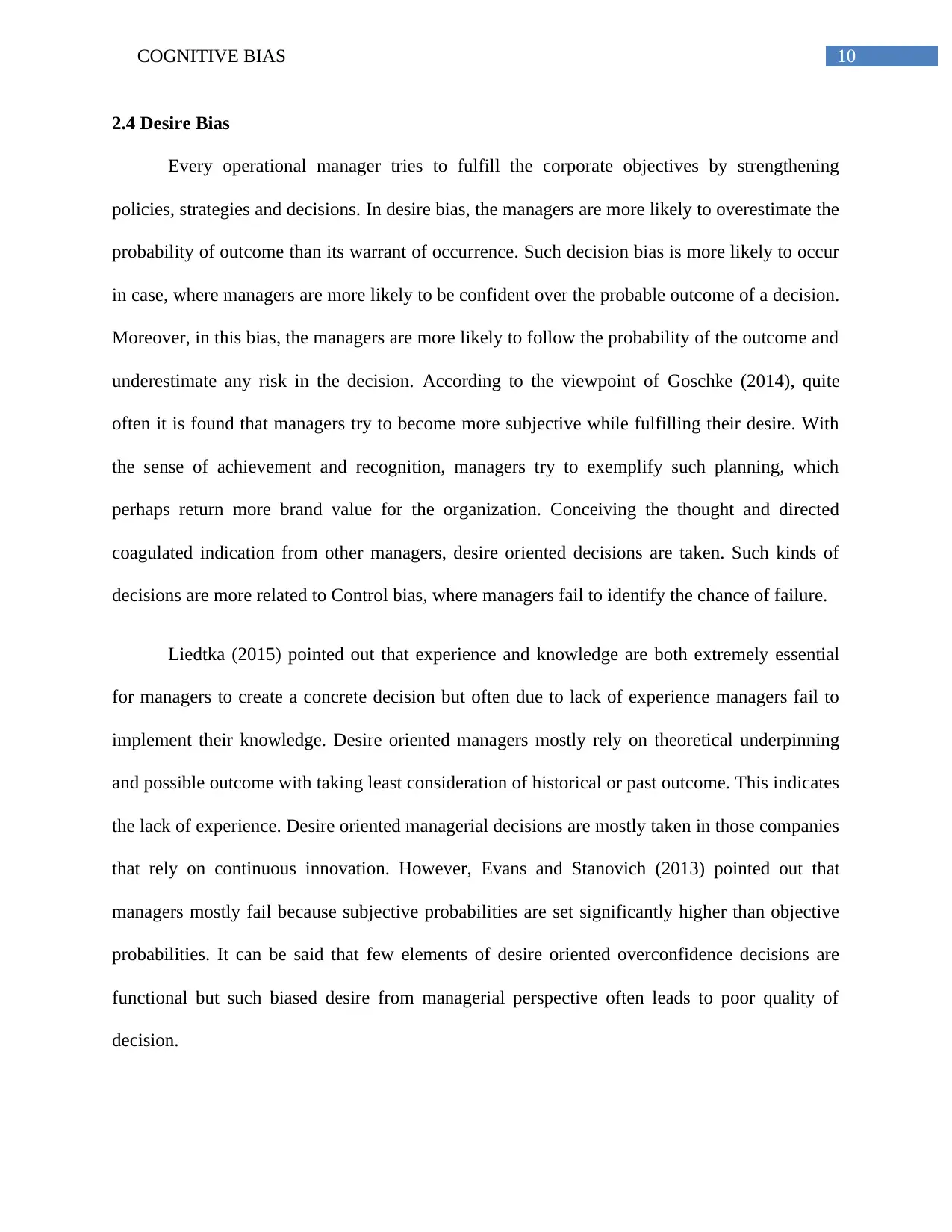
10COGNITIVE BIAS
2.4 Desire Bias
Every operational manager tries to fulfill the corporate objectives by strengthening
policies, strategies and decisions. In desire bias, the managers are more likely to overestimate the
probability of outcome than its warrant of occurrence. Such decision bias is more likely to occur
in case, where managers are more likely to be confident over the probable outcome of a decision.
Moreover, in this bias, the managers are more likely to follow the probability of the outcome and
underestimate any risk in the decision. According to the viewpoint of Goschke (2014), quite
often it is found that managers try to become more subjective while fulfilling their desire. With
the sense of achievement and recognition, managers try to exemplify such planning, which
perhaps return more brand value for the organization. Conceiving the thought and directed
coagulated indication from other managers, desire oriented decisions are taken. Such kinds of
decisions are more related to Control bias, where managers fail to identify the chance of failure.
Liedtka (2015) pointed out that experience and knowledge are both extremely essential
for managers to create a concrete decision but often due to lack of experience managers fail to
implement their knowledge. Desire oriented managers mostly rely on theoretical underpinning
and possible outcome with taking least consideration of historical or past outcome. This indicates
the lack of experience. Desire oriented managerial decisions are mostly taken in those companies
that rely on continuous innovation. However, Evans and Stanovich (2013) pointed out that
managers mostly fail because subjective probabilities are set significantly higher than objective
probabilities. It can be said that few elements of desire oriented overconfidence decisions are
functional but such biased desire from managerial perspective often leads to poor quality of
decision.
2.4 Desire Bias
Every operational manager tries to fulfill the corporate objectives by strengthening
policies, strategies and decisions. In desire bias, the managers are more likely to overestimate the
probability of outcome than its warrant of occurrence. Such decision bias is more likely to occur
in case, where managers are more likely to be confident over the probable outcome of a decision.
Moreover, in this bias, the managers are more likely to follow the probability of the outcome and
underestimate any risk in the decision. According to the viewpoint of Goschke (2014), quite
often it is found that managers try to become more subjective while fulfilling their desire. With
the sense of achievement and recognition, managers try to exemplify such planning, which
perhaps return more brand value for the organization. Conceiving the thought and directed
coagulated indication from other managers, desire oriented decisions are taken. Such kinds of
decisions are more related to Control bias, where managers fail to identify the chance of failure.
Liedtka (2015) pointed out that experience and knowledge are both extremely essential
for managers to create a concrete decision but often due to lack of experience managers fail to
implement their knowledge. Desire oriented managers mostly rely on theoretical underpinning
and possible outcome with taking least consideration of historical or past outcome. This indicates
the lack of experience. Desire oriented managerial decisions are mostly taken in those companies
that rely on continuous innovation. However, Evans and Stanovich (2013) pointed out that
managers mostly fail because subjective probabilities are set significantly higher than objective
probabilities. It can be said that few elements of desire oriented overconfidence decisions are
functional but such biased desire from managerial perspective often leads to poor quality of
decision.
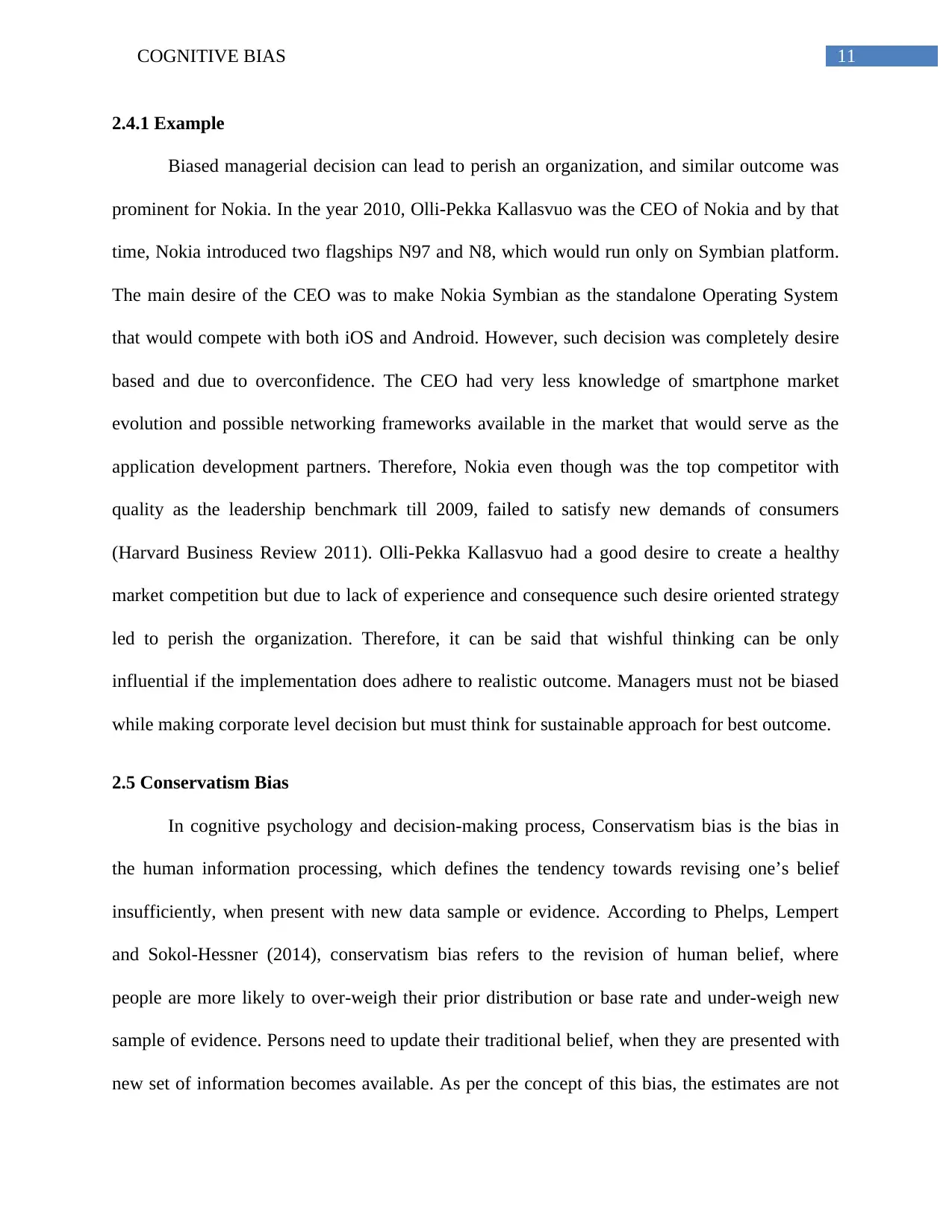
11COGNITIVE BIAS
2.4.1 Example
Biased managerial decision can lead to perish an organization, and similar outcome was
prominent for Nokia. In the year 2010, Olli-Pekka Kallasvuo was the CEO of Nokia and by that
time, Nokia introduced two flagships N97 and N8, which would run only on Symbian platform.
The main desire of the CEO was to make Nokia Symbian as the standalone Operating System
that would compete with both iOS and Android. However, such decision was completely desire
based and due to overconfidence. The CEO had very less knowledge of smartphone market
evolution and possible networking frameworks available in the market that would serve as the
application development partners. Therefore, Nokia even though was the top competitor with
quality as the leadership benchmark till 2009, failed to satisfy new demands of consumers
(Harvard Business Review 2011). Olli-Pekka Kallasvuo had a good desire to create a healthy
market competition but due to lack of experience and consequence such desire oriented strategy
led to perish the organization. Therefore, it can be said that wishful thinking can be only
influential if the implementation does adhere to realistic outcome. Managers must not be biased
while making corporate level decision but must think for sustainable approach for best outcome.
2.5 Conservatism Bias
In cognitive psychology and decision-making process, Conservatism bias is the bias in
the human information processing, which defines the tendency towards revising one’s belief
insufficiently, when present with new data sample or evidence. According to Phelps, Lempert
and Sokol-Hessner (2014), conservatism bias refers to the revision of human belief, where
people are more likely to over-weigh their prior distribution or base rate and under-weigh new
sample of evidence. Persons need to update their traditional belief, when they are presented with
new set of information becomes available. As per the concept of this bias, the estimates are not
2.4.1 Example
Biased managerial decision can lead to perish an organization, and similar outcome was
prominent for Nokia. In the year 2010, Olli-Pekka Kallasvuo was the CEO of Nokia and by that
time, Nokia introduced two flagships N97 and N8, which would run only on Symbian platform.
The main desire of the CEO was to make Nokia Symbian as the standalone Operating System
that would compete with both iOS and Android. However, such decision was completely desire
based and due to overconfidence. The CEO had very less knowledge of smartphone market
evolution and possible networking frameworks available in the market that would serve as the
application development partners. Therefore, Nokia even though was the top competitor with
quality as the leadership benchmark till 2009, failed to satisfy new demands of consumers
(Harvard Business Review 2011). Olli-Pekka Kallasvuo had a good desire to create a healthy
market competition but due to lack of experience and consequence such desire oriented strategy
led to perish the organization. Therefore, it can be said that wishful thinking can be only
influential if the implementation does adhere to realistic outcome. Managers must not be biased
while making corporate level decision but must think for sustainable approach for best outcome.
2.5 Conservatism Bias
In cognitive psychology and decision-making process, Conservatism bias is the bias in
the human information processing, which defines the tendency towards revising one’s belief
insufficiently, when present with new data sample or evidence. According to Phelps, Lempert
and Sokol-Hessner (2014), conservatism bias refers to the revision of human belief, where
people are more likely to over-weigh their prior distribution or base rate and under-weigh new
sample of evidence. Persons need to update their traditional belief, when they are presented with
new set of information becomes available. As per the concept of this bias, the estimates are not
⊘ This is a preview!⊘
Do you want full access?
Subscribe today to unlock all pages.

Trusted by 1+ million students worldwide
1 out of 27
Your All-in-One AI-Powered Toolkit for Academic Success.
+13062052269
info@desklib.com
Available 24*7 on WhatsApp / Email
![[object Object]](/_next/static/media/star-bottom.7253800d.svg)
Unlock your academic potential
Copyright © 2020–2025 A2Z Services. All Rights Reserved. Developed and managed by ZUCOL.